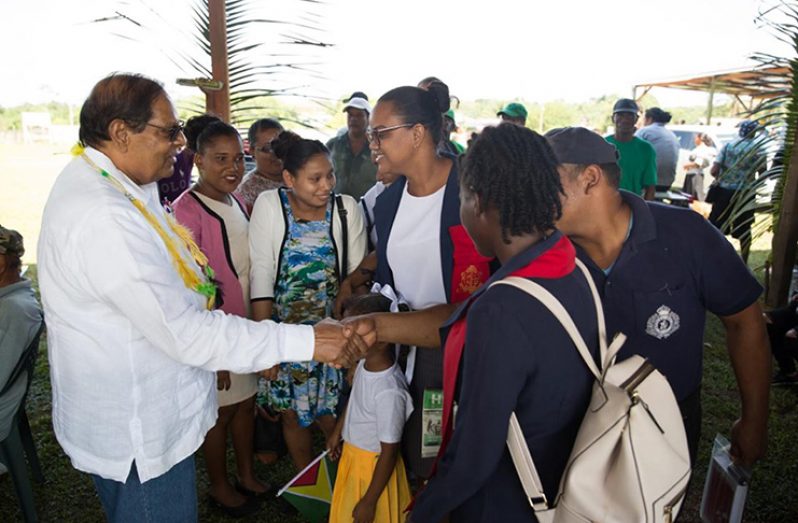…PM says community transformed from shanty town to modern neighbourhood
PRIME Minister Moses Nagamootoo has asserted that Port Kaituma is being transformed from a rustic, shanty town into a modern settlement. He recounted that he landed on an expanded, asphalted runway, and travelled along freshly graded roads, parts of which were solid concrete pavements.
In his recent column, My Turn, the prime minister recalled visiting Port Kaituma as a minister in a previous government, when it was a “cluster of shacks running on both sides of what used to be a red-looking, muddied dam.”
President David Granger last Friday visited this hinterland mining settlement, which is located in the Barima-Waini (Region One), that borders Venezuela on the west. He received a big welcome from residents, who waved Guyana flags and held up posters with slogans in support of his government.
President Granger took his message of the great changes under his government in far-off, hinterland communities, and gave assurances that much more would be done during the ‘decade of development’ (2020-2029).

Again, he gave the assurance of free education from nursery to university, and equitable distribution of oil revenues to benefit indigenous peoples and other hinterland communities.
In his column, Prime Minister Nagamootoo said that there are some 270 schools that are spread across the vast hinterland regions – 116 nursery, 141 primary, and 13 secondary. In these communities, there are also some 151 health centres and health posts.
Writing about changes in what used to be called the “North-West District,” Prime Minister Nagamootoo gave credit to the APNU+AFC Coalition Government for the reintroduction of reliable ferry service between Barima-Waini and Georgetown. Soon, he said, residents will get improved potable water and electricity services.
Recently, 79 titles to land were distributed in Matthew’s Ridge, and 25 houses handed out to residents of Sebai, an indigenous village in the Matarkai sub-region.
“Similar changes have recently taken place at the Moruca sub-region, notably the completion of the Bemichi airstrip, a modern bridge at Moruca, and a cassava flour factory at Kwebanna,” the prime minister noted.
The prime minister’s comments were made after he attended a government outreach in Port Kaituma along with several ministers including indigenous leaders, Vice-president Sydney Allicock; Ministers Dawn Hasting-Williams and Valerie Garrido-Lowe and Raymond James, Toshao of Sebai.
According to the 2012 census, Indigenous peoples make up 10.51 per cent of Guyana’s population, and they populate some 13 per cent of the country’s territory. They comprise about six per cent of voters.
The indigenous population consists of the Akawaio, Arekuna, Arawak, Macushi, Wapichan, Patamona, Wai Wai, Warrau and the Carib nations, who are organised under 116 village councils.
Their customs and culture are presently being showcased during this September Indigenous Heritage Month, including a high-profile Indigenous Heritage Pageant.
The prime minister noted that there is much to celebrate, including the establishment under the coalition government of four new towns: Bartica, Mabaruma, Mahdia and Lethem, and several radio stations at Lethem, Mahdia, Aishalton, Mabaruma, Paiwomak, Orealla and Bartica.
Between 2015 and 2018, the coalition government invested $48 billion on expanding, maintaining and constructing roads and bridges in the hinterland; an additional $38.5 billion was approved to continue this process this year.



.jpg)








